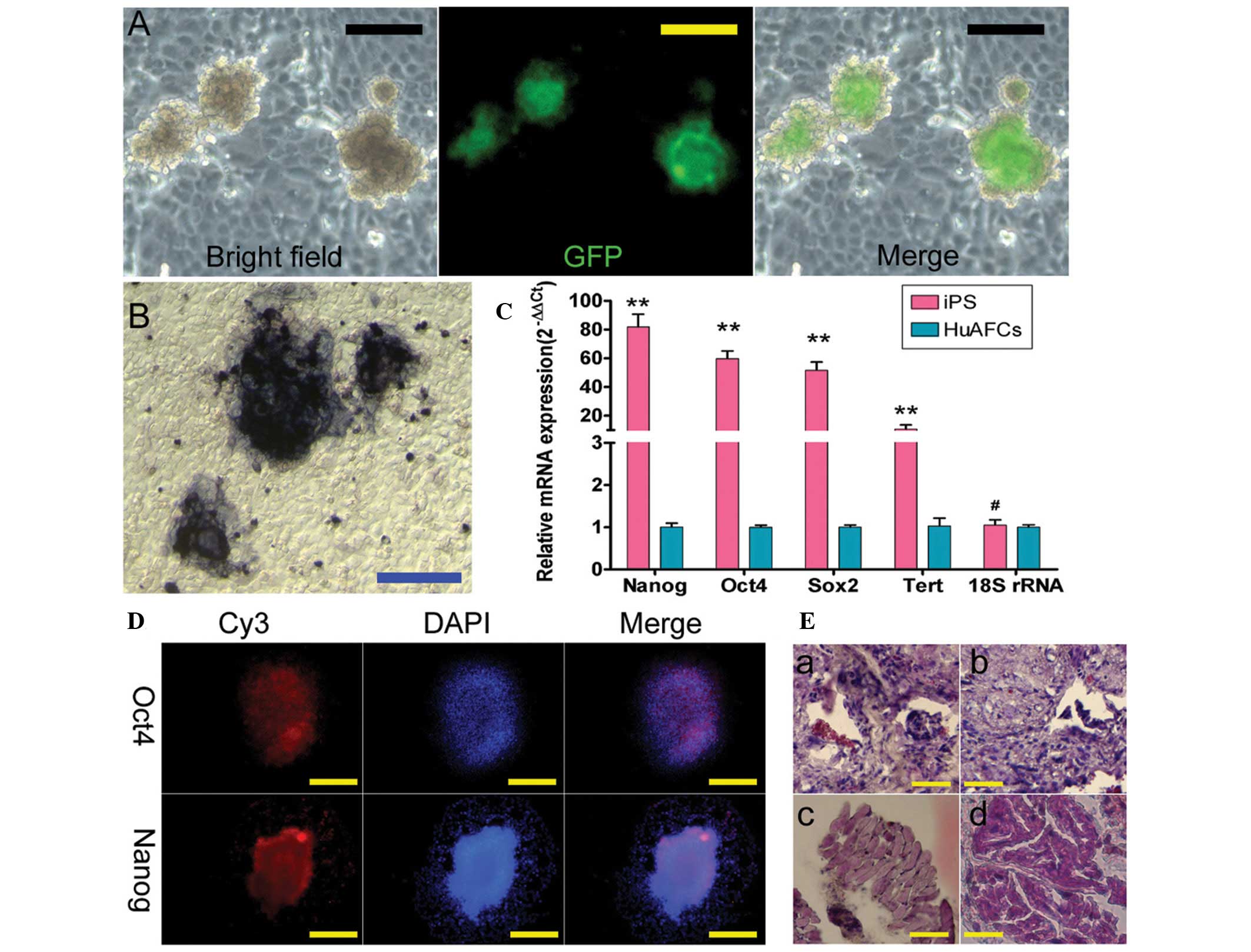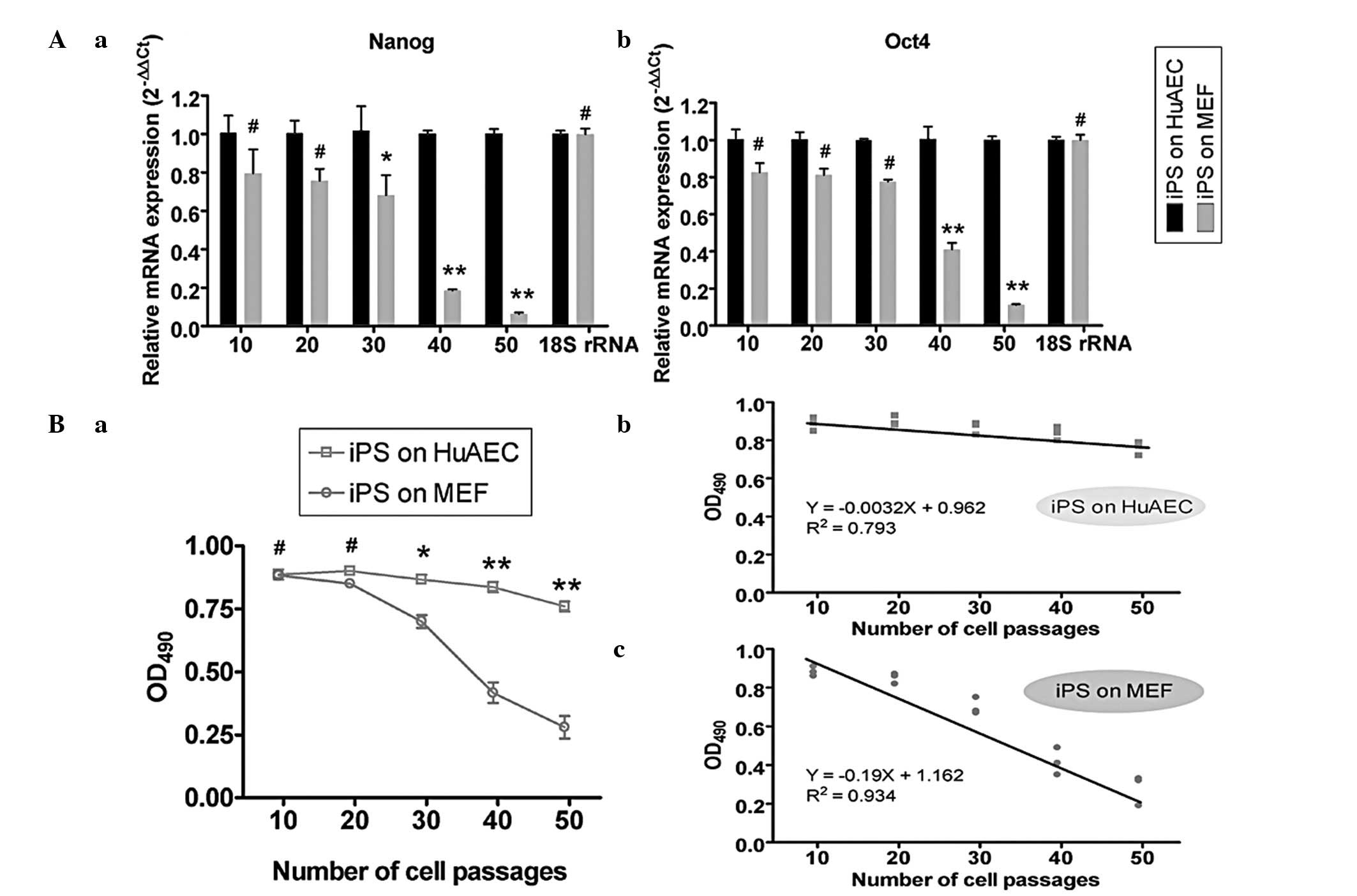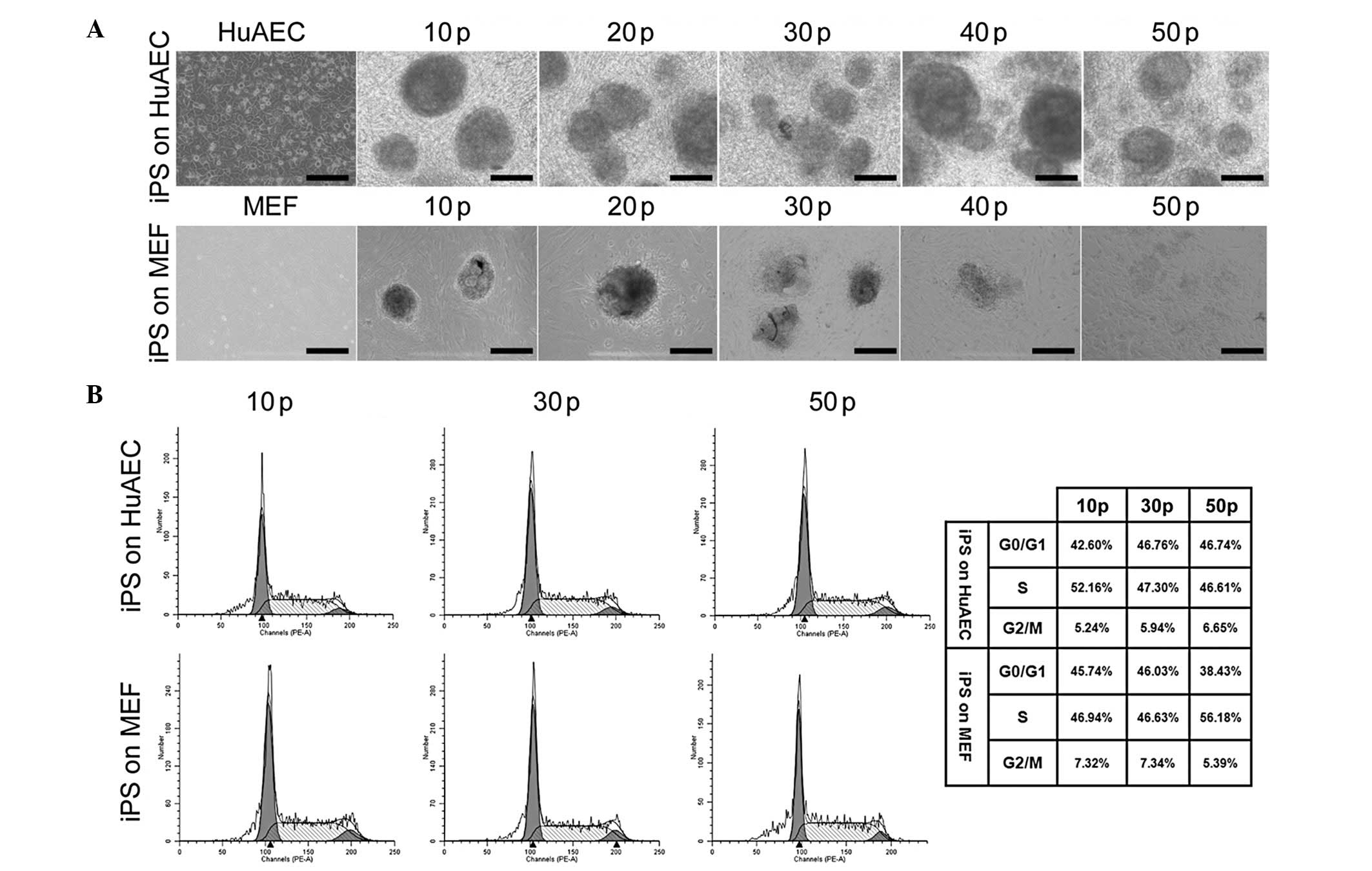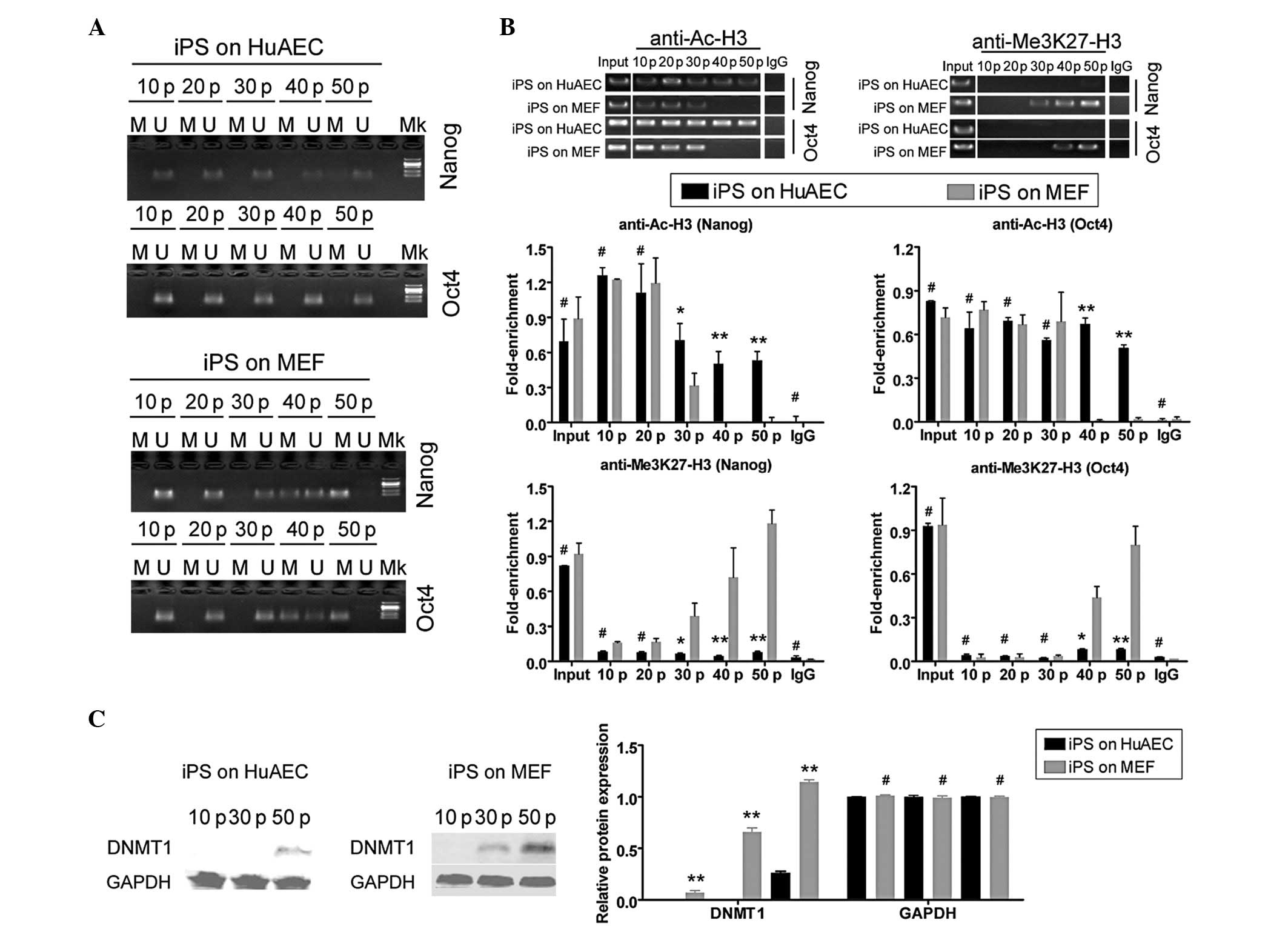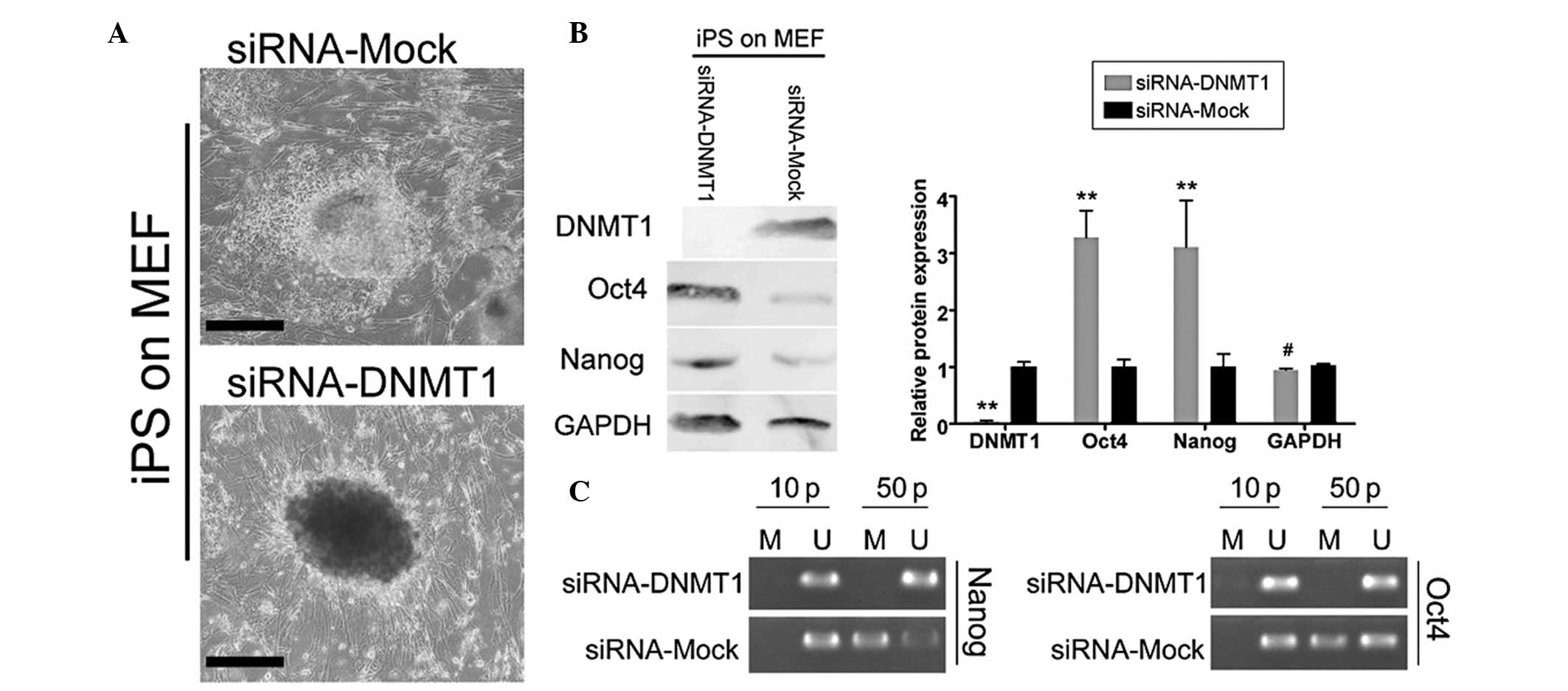|
1.
|
Takahashi K and Yamanaka S: Induction of
pluripotent stem cells from mouse embryonic and adult fibroblast
cultures by defined factors. Cell. 126:663–676. 2006. View Article : Google Scholar : PubMed/NCBI
|
|
2.
|
Takahashi K, Tanabe K, Ohnuki M, et al:
Induction of pluripotent stem cells from adult human fibroblasts by
defined factors. Cell. 131:861–872. 2007. View Article : Google Scholar
|
|
3.
|
Galach M and Utikal J: From skin to the
treatment of diseases - the possibilities of iPS cell research in
dermatology. Exp Dermatol. 20:523–528. 2011. View Article : Google Scholar : PubMed/NCBI
|
|
4.
|
Maherali N, Sridharan R, Xie W, et al:
Directly reprogrammed fibroblasts show global epigenetic remodeling
and widespread tissue contribution. Cell Stem Cell. 1:55–70.
2007.PubMed/NCBI
|
|
5.
|
Okita K, Ichisaka T and Yamanaka S:
Generation of germline-competent induced pluripotent stem cells.
Nature. 448:313–317. 2007. View Article : Google Scholar : PubMed/NCBI
|
|
6.
|
Hanna J, Markoulaki S, Schorderet P, et
al: Direct reprogramming of terminally differentiated mature B
lymphocytes to pluripotency. Cell. 133:250–264. 2008. View Article : Google Scholar : PubMed/NCBI
|
|
7.
|
Wernig M, Meissner A, Foreman R, et al: In
vitro reprogramming of fibroblasts into a pluripotent ES-cell-like
state. Nature. 448:318–324. 2007. View Article : Google Scholar : PubMed/NCBI
|
|
8.
|
Liu H, Zhu F, Yong J, et al: Generation of
induced pluripotent stem cells from adult rhesus monkey
fibroblasts. Cell Stem Cell. 3:587–590. 2008. View Article : Google Scholar : PubMed/NCBI
|
|
9.
|
Yu J, Vodyanik MA, Smuga-Otto K, et al:
Induced pluripotent stem cell lines derived from human somatic
cells. Science. 318:1917–1920. 2007. View Article : Google Scholar : PubMed/NCBI
|
|
10.
|
Thier M, Munst B and Edenhofer F:
Exploring refined conditions for reprogramming cells by recombinant
Oct4 protein. Int J Dev Biol. 54:1713–1721. 2010. View Article : Google Scholar : PubMed/NCBI
|
|
11.
|
Zhong B, Watts KL, Gori JL, et al:
Safeguarding nonhuman primate iPS cells with suicide genes. Mol
Ther. 19:1667–1675. 2011. View Article : Google Scholar : PubMed/NCBI
|
|
12.
|
Ye Z, Zhan H, Mali P, et al: Human-induced
pluripotent stem cells from blood cells of healthy donors and
patients with acquired blood disorders. Blood. 114:5473–5480. 2009.
View Article : Google Scholar : PubMed/NCBI
|
|
13.
|
Ezashi T, Telugu BP, Alexenko AP, Sachdev
S, Sinha S and Roberts RM: Derivation of induced pluripotent stem
cells from pig somatic cells. Proc Natl Acad Sci USA.
106:10993–10998. 2009. View Article : Google Scholar : PubMed/NCBI
|
|
14.
|
Gonzalez F, Barragan Monasterio M,
Tiscornia G, et al: Generation of mouse-induced pluripotent stem
cells by transient expression of a single nonviral polycistronic
vector. Proc Natl Acad Sci USA. 106:8918–8922. 2009. View Article : Google Scholar : PubMed/NCBI
|
|
15.
|
Kaji K, Norrby K, Paca A, Mileikovsky M,
Mohseni P and Woltjen K: Virus-free induction of pluripotency and
subsequent excision of reprogramming factors. Nature. 458:771–775.
2009. View Article : Google Scholar : PubMed/NCBI
|
|
16.
|
Zhou H, Wu S, Joo JY, et al: Generation of
induced pluripotent stem cells using recombinant proteins. Cell
Stem Cell. 4:381–384. 2009. View Article : Google Scholar : PubMed/NCBI
|
|
17.
|
Yakubov E, Rechavi G, Rozenblatt S and
Givol D: Reprogramming of human fibroblasts to pluripotent stem
cells using mRNA of four transcription factors. Biochem Biophys Res
Commun. 394:189–193. 2010. View Article : Google Scholar : PubMed/NCBI
|
|
18.
|
Liu T, Cheng W, Liu T, et al: Human
amniotic epithelial cell feeder layers maintain mouse embryonic
stem cell pluripotency via epigenetic regulation of the c-Myc
promoter. Acta Biochim Biophys Sin (Shanghai). 42:109–115. 2010.
View Article : Google Scholar : PubMed/NCBI
|
|
19.
|
Liu T, Guo L, Liu Z and Cheng W: Human
amniotic epithelial cells maintain mouse spermatogonial stem cells
in an undifferentiated state due to high leukemia inhibitor factor
(LIF) expression. In Vitro Cell Dev Biol Anim. 47:318–326. 2011.
View Article : Google Scholar
|
|
20.
|
Liu T, Wu J, Huang Q, et al: Human
amniotic epithelial cells ameliorate behavioral dysfunction and
reduce infarct size in the rat middle cerebral artery occlusion
model. Shock. 29:603–611. 2008.
|
|
21.
|
Liu T, Cheng W, Huang Y, Huang Q, Jiang L
and Guo L: Human amniotic epithelial cell feeder layers maintain
human iPS cell pluripotency via inhibited endogenous microRNA-145
and increased Sox2 expression. Exp Cell Res. 318:424–434. 2012.
View Article : Google Scholar : PubMed/NCBI
|
|
22.
|
Hattori N, Imao Y, Nishino K, et al:
Epigenetic regulation of Nanog gene in embryonic stem and
trophoblast stem cells. Genes Cells. 12:387–396. 2007. View Article : Google Scholar : PubMed/NCBI
|
|
23.
|
Cowan CA, Atienza J, Melton DA and Eggan
K: Nuclear reprogramming of somatic cells after fusion with human
embryonic stem cells. Science. 309:1369–1373. 2005. View Article : Google Scholar : PubMed/NCBI
|
|
24.
|
Freberg CT, Dahl JA, Timoskainen S and
Collas P: Epigenetic reprogramming of OCT4 and NANOG regulatory
regions by embryonal carcinoma cell extract. Mol Biol Cell.
18:1543–1553. 2007. View Article : Google Scholar : PubMed/NCBI
|
|
25.
|
Simonsson S and Gurdon J: DNA
demethylation is necessary for the epigenetic reprogramming of
somatic cell nuclei. Nat Cell Biol. 6:984–990. 2004. View Article : Google Scholar : PubMed/NCBI
|
|
26.
|
Tada M, Tada T, Lefebvre L, Barton SC and
Surani MA: Embryonic germ cells induce epigenetic reprogramming of
somatic nucleus in hybrid cells. EMBO J. 16:6510–6520. 1997.
View Article : Google Scholar : PubMed/NCBI
|
|
27.
|
Bibikova M, Chudin E, Wu B, et al: Human
embryonic stem cells have a unique epigenetic signature. Genome
Res. 16:1075–1083. 2006. View Article : Google Scholar : PubMed/NCBI
|
|
28.
|
Li JY, Pu MT, Hirasawa R, et al:
Synergistic function of DNA methyltransferases Dnmt3a and Dnmt3b in
the methylation of Oct4 and Nanog. Mol Cell Biol. 27:8748–8759.
2007. View Article : Google Scholar : PubMed/NCBI
|
|
29.
|
Delgado-Olguin P and Recillas-Targa F:
Chromatin structure of pluripotent stem cells and induced
pluripotent stem cells. Brief Funct Genomics. 10:37–49. 2011.
View Article : Google Scholar : PubMed/NCBI
|
|
30.
|
Athanasiadou R, de Sousa D, Myant K,
Merusi C, Stancheva I and Bird A: Targeting of de novo DNA
methylation throughout the Oct-4 gene regulatory region in
differentiating embryonic stem cells. PLoS One. 5:e99372010.
View Article : Google Scholar : PubMed/NCBI
|
|
31.
|
Tsumura A, Hayakawa T, Kumaki Y, et al:
Maintenance of self-renewal ability of mouse embryonic stem cells
in the absence of DNA methyltransferases Dnmt1, Dnmt3a and Dnmt3b.
Genes Cells. 11:805–814. 2006. View Article : Google Scholar : PubMed/NCBI
|
|
32.
|
Fatemi M, Hermann A, Pradhan S and Jeltsch
A: The activity of the murine DNA methyltransferase Dnmt1 is
controlled by interaction of the catalytic domain with the
N-terminal part of the enzyme leading to an allosteric activation
of the enzyme after binding to methylated DNA. J Mol Biol.
309:1189–1199. 2001. View Article : Google Scholar : PubMed/NCBI
|
|
33.
|
Sen GL, Reuter JA, Webster DE, Zhu L and
Khavari PA: DNMT1 maintains progenitor function in self-renewing
somatic tissue. Nature. 463:563–567. 2010. View Article : Google Scholar : PubMed/NCBI
|
|
34.
|
Mikkelsen TS, Hanna J, Zhang X, et al:
Dissecting direct reprogramming through integrative genomic
analysis. Nature. 454:49–55. 2008. View Article : Google Scholar : PubMed/NCBI
|
|
35.
|
Datta J, Ghoshal K, Sharma SM, Tajima S
and Jacob ST: Biochemical fractionation reveals association of DNA
methyltransferase (Dnmt) 3b with Dnmt1 and that of Dnmt 3a with a
histone H3 methyltransferase and Hdac1. J Cell Biochem. 88:855–864.
2003. View Article : Google Scholar : PubMed/NCBI
|
|
36.
|
Ohi Y, Qin H, Hong C, et al: Incomplete
DNA methylation underlies a transcriptional memory of somatic cells
in human iPS cells. Nat Cell Biol. 13:541–549. 2011. View Article : Google Scholar : PubMed/NCBI
|
|
37.
|
Liu T, Zou G, Gao Y, et al: High
efficiency of reprogramming CD34+ cells derived from
human amniotic fluid into induced pluripotent stem cells with Oct4.
Stem Cells Dev. 21:2322–2332. 2012.PubMed/NCBI
|
|
38.
|
Miyabayashi T, Teo JL, Yamamoto M,
McMillan M, Nguyen C and Kahn M: Wnt/beta-catenin/CBP signaling
maintains long-term murine embryonic stem cell pluripotency. Proc
Natl Acad Sci USA. 104:5668–5673. 2007. View Article : Google Scholar : PubMed/NCBI
|
|
39.
|
Lai D, Cheng W and Liu T, Jiang L, Huang Q
and Liu T: Use of human amnion epithelial cells as a feeder layer
to support undifferentiated growth of mouse embryonic stem cells.
Cloning Stem Cells. 11:331–340. 2009. View Article : Google Scholar : PubMed/NCBI
|
|
40.
|
Lai D, Cheng W, Liu T, Jiang L, Liu T,
Huang Q and Guo L: Optimization of culture conditions to support
undifferentiated growth of human embryonic stem cells. Cell
Reprogram. 12:305–314. 2010. View Article : Google Scholar : PubMed/NCBI
|
|
41.
|
Guo Y, Liu S, Wang P, et al: Expression
profile of embryonic stem cell-associated genes Oct4, Sox2 and
Nanog in human gliomas. Histopathology. 59:763–775. 2011.
View Article : Google Scholar : PubMed/NCBI
|
|
42.
|
Robertson KD, Uzvolgyi E, Liang G, et al:
The human DNA methyltransferases (DNMTs) 1, 3a and 3b: coordinate
mRNA expression in normal tissues and overexpression in tumors.
Nucleic Acids Res. 27:2291–2298. 1999. View Article : Google Scholar : PubMed/NCBI
|
|
43.
|
Liu T, Chen Q, Huang Y, Huang Q, Jiang L
and Guo L: Low microRNA-199a expression in human amniotic
epithelial cell feeder layers maintains human-induced pluripotent
stem cell pluripotency via increased leukemia inhibitory factor
expression. Acta Biochim Biophys Sin (Shanghai). 44:197–206. 2012.
View Article : Google Scholar
|
|
44.
|
Miki T, Lehmann T, Cai H, Stolz DB and
Strom SC: Stem cell characteristics of amniotic epithelial cells.
Stem Cells. 23:1549–1559. 2005. View Article : Google Scholar : PubMed/NCBI
|















